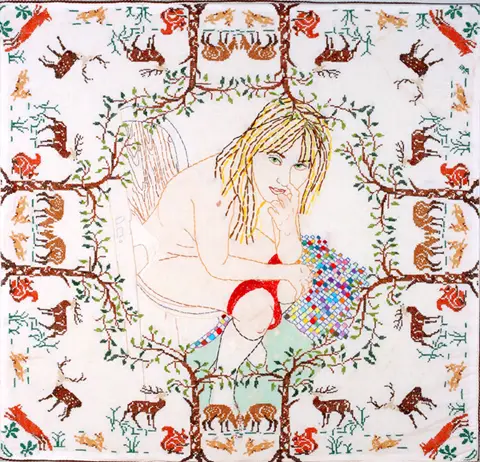This past week, I’ve been thinking a lot about historical needlework. My friends Donna Drachunas and Ava Coleman just started a pattern-publication series called Stories in Stitches, featuring traditions and histories tied together with knitting projects. Donna has been posting photos of surviving needlework on her Pinterest page, including one photo of knitted gloves from at least 1247. I got stuck in the moment, in awe: that’s eight hundred years ago. The pair was stitched in silk too.
Donna’s pin led me to create a History board on Kreinik’s Pinterest page, and I began sharing photos of anything embroidered throughout the ages. Probably due to the recent Great Gatsby movie, I really delighted in finding embroidered flapper dresses. I love samplers, but European clothing (anything of the Jane Austen era has my heart) and ecclesiastical vestments are nothing short of stunning stitchery as well. Spend an hour, or 30, looking at historical embroidery on Pinterest though, and you begin to recognize the common threads that run through them: literally and specifically, silk and metallic threads.
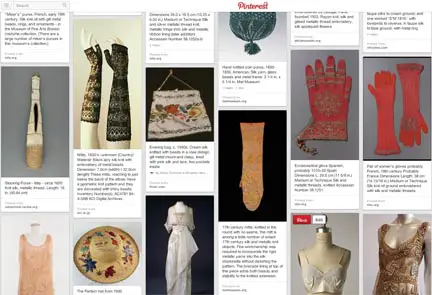
Before I talk threads, let me just say that our fore-stitchers embroidered the heck out of things. Church textiles, hats, skirts, gloves, shoes, buttons, undergarments, pillows, curtains, table linens, boxes, coffins…everything. “Plain and ornamental needle-work” was a standard part of a young girl’s education in some cultures. In others, a man really showed his worth if he was a master embroiderer. You were a woman of fine standing if you did needlework or wore heavily decorated clothing, but given the amount of fancy stitching on men’s coats and uniforms, guys surely liked being well-stitched too.
In most eras, it took a bit of money—at least a middle-class living—to buy stitching materials or have a needlework teacher. In 1811, a schoolgirl spent $7.44 for 81 skeins of silk embroidery floss (as mentioned in Sampler & Antique Needlework Quarterly magazine). I have no idea what that is in today’s dollars, but back then, while expensive, it was considered necessary, standard, and money well spent.
A scholarly approach to historical textiles analyzes the symbolism of the stitched motifs, elements and shapes that could be regionally or religiously influenced. However, look at antique crazy quilts and you know those stitchers had a little free-form fun too. For centuries, needlework has been done by all cultures, all ages, all classes, all skill levels. You know stitchers back then got excited over thread colors, making pictures on fabric, seeing the end result, and leaving their embroidery mark on the world. This week in a conversation on Twitter, a stitcher said, “Don’t u wish u could talk w/those girls about their choices & designs. Feel like I know her when I finish a reproduction.” So true; needlework connects us with humans from any time period.
What is interesting about all of this historical textile talk is that we use some of these same needlework materials in our current day. It’s not just the fact that we are still embroidering, but it’s what we stitch with and stitch on that connects us as well. You, me, Mr XStitch, and all of our stitching friends have access to the same kind of materials our fore-stitchers used. I think that’s pretty cool.
Here’s a quick look at four historical supplies we have today:
Silk Thread
Most people think of silk as being delicate, rare, and difficult. Actually, silk was the thread du jour for thousands of years. Silk by its nature is so durable and strong that it lasts about that long, too. Silk embroidery 2100 to 3000 years old has been found in tombs in China, the country that ruled the road on this fiber production for a long time. Eventually other countries were able to manufacture silk thread, and then it was used by everyone. You had your spun silk, filament silk, twisted silk, flat silk…sometimes silk yarn used in embroidery came from unravelling silk fabrics from the Orient. In whatever form they could get it, everyone from schoolgirls making samplers to clothing makers-to-the-stars and religious stitchers-for-the-church embroidered with silk. (Cotton floss is the baby fiber for us today, born barely “a few” years ago compared to silk.) I like to imagine that since the cellular structure of silk makes colors so rich and vibrant, even stitchers back then couldn’t help but make something with it.
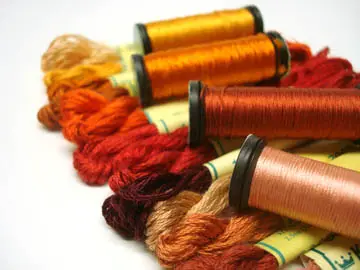
Metallic Thread
When I go to trade shows for Kreinik, I see a handful of people put up their hand and say, “Nooo, metallics are NOT for me” (even though they are wearing silver jewelry and clothes with metallic accents…). Well, metallics were for pretty much everyone else since at least the BC times. First it was real gold and silver, solid stuff, to decorate textiles. I read about a fabric remnant from 400 BC that weighed close to 40 pounds just from the metallic embellishment. Fortunately, people developed more flexible and lightweight stuff. A core fiber was coated with a thin layer of the real metal, which was nice because you could use these in weaving too, besides embroidery. That lasted for centuries until needleworkers realized they needed something with the same look but less expensive, easier to make, softer, more care-friendly, and non-tarnishing—meaning, the metallic threads we have today.
Most of the historical needlework you read about today mentions gold and silver thread. For surface decoration, there was (is) nothing more eye catching. It was a status symbol, indicating rank, wealth, nobility, point of pride. However, there is also a historical textile category known as “metallic folk embroidery.” That’s right, metallics were for all folks. We’re talking court AND folk embroidery, men and women, different regions, all classes, levels, skills. (Uh, nevermind about that dark part of Massachusetts history when it was illegal for lower class colonists to wear anything with gold or silver thread; that law didn’t last long anyway.) Whether the stitching was simply done on a cuff, collar, or hem—or elaborately on an entire coat, altarpiece, or curtain—metallics were there for the variety, gorgeousness, texture and dimension to make the design better. It seems that as humans we are naturally drawn to shiny things.
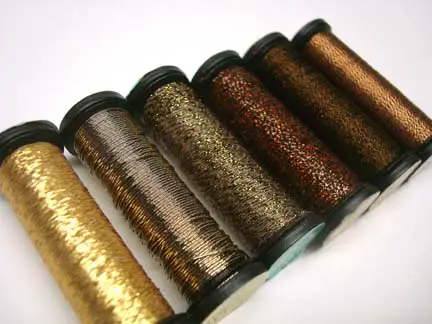
Silk Gauze
Silk what? Kreinik sells silk gauze in all sizes, and it’s a top-secret needlework fabric. Well, not really, but most people haven’t heard of it. In fact, however, this sheer, open-weave fabric made of pure silk was common in historical needlework. Our fore-stitchers had silk, they knew how to weave, and they put the two together. It was sheer, lightweight but sturdy, strong, and you could embroider on it. It was good for clothes (a silk gauze robe was found in a tomb dating to 800 BC) and for samplers (Sampler and Antique Needlework Quarterly recently featured a design that a 9-year-old stitched in silk thread on 55-count silk gauze, in 1806). I was first introduced to stitching on gauze about 20 years ago, when I saw a girl’s sampler stitched on gauze wrapping from a Civil War soldier. As a material, silk gauze is not used for bandages, but you can see how appealing that kind of fabric would be for “something different.” It’s strength and lightweight qualities made it interesting and useful for many embroidery applications.
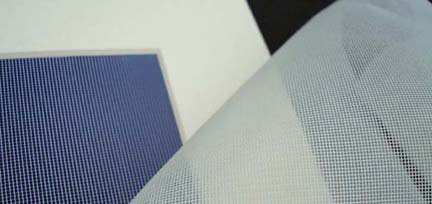
Paillettes
Real-metal sequins have embellished everything from the emperor’s new clothes to the belly dancer’s veils. We just can’t help but love spangles; I bet you have some colored plastic ones in your craft drawer now, or had a spangled costume when you were growing up. We be-jeweled our way through the 1980s and 90s, just like they did through the 1880s, 1780s, 1680s, and so on. Paillettes, orbs of real-metals, were the ones in use during the pre-plastic centuries, as far back as 2500 BC give or take, dotting textiles like little suns in solar systems or gold coins in a fountain.
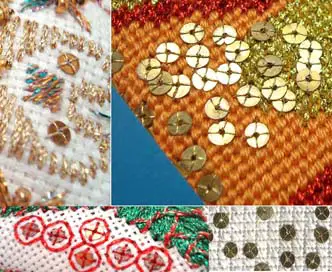
If you want to use these materials today, this is what I recommend:
1. For silk threads, start with a silk embroidery floss, mostly because it is similar to the cotton embroidery floss we use more often. Kreinik makes Silk Mori which is a 6-ply silk floss. Use as many strands as you need for whatever you are stitching, i.e, two strands on 14-count Aida. It’s beautiful and perfect for beginners. Here’s a helpful link.
2. For metallic threads, start with a metallic braid. It’s not whisper-thin like Blending Filament, so it is easier to use and stronger. Braids are softer than floss, cords, or metallic cables, so they are flexible, not heavy, not pokey. Don’t try to separate metallic braid like floss – just use it as it comes. Kreinik makes different weights, or sizes, of metallic braids, so pick the size that fits your ground fabric. You can find many gold and silver shades, but feel free to branch out and choose a color. Our ancestors would have loved the options we have today. Blatant self-promotion: the Kreinik website is full of everything you really want to know about metallics, and I share a lot on my Twitter feed as well.
3. For gauze, I don’t recommend trying to stitch on the stuff you find in your grandparent’s medicine cabinet. Choose pure silk gauze, which is stronger. Buy a small piece, framed on matboard which makes it easy to hold, in a size you are comfortable with, such as 18-count. Eventually you can upgrade to stitching over one on 40-count silk gauze where you will fall in love with miniature embroidery (but I recommend you do it before your eyes turn 40, unless you use a magnifier). See more about silk gauze here.
4. Buy a 1-gram package of paillettes to start with and tack them to your next stitching project like a bead or button. It’s just that easy. Learn more about paillettes here and here.

I love doing cross stitch, needlepoint, and quilting, so I appreciate all the work people have stitched before my time or around me, and I bet you feel the same. Visit the History board on our Pinterest page here. Start your own, collecting images (or actual pieces) of historical embroidery that resonate with you. We are lucky that we can use similar materials that stitchers have been using for centuries, which connects our generations more tangibly than the emotional bonds of making something with our hands and expressing ourselves. These materials have been all about making stitchery more interesting, playing with depth, texture and finishes. I’m no anthropologist, but men and women, children and adults inherently seem to know that even basic stitches can be embellishment, and even the simple choice of thread can make those stitches more exciting.
—–
Dena Lenham, aka KreinikGirl, is Creative Director at Kreinik Manufacturing Company, a family-owned, USA-based business that manufactures high-quality yarns and threads made of metallics, silks and real metals from their West Virginia factory.




